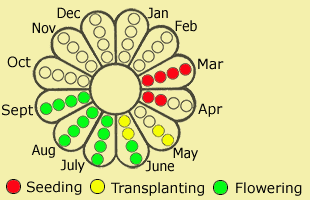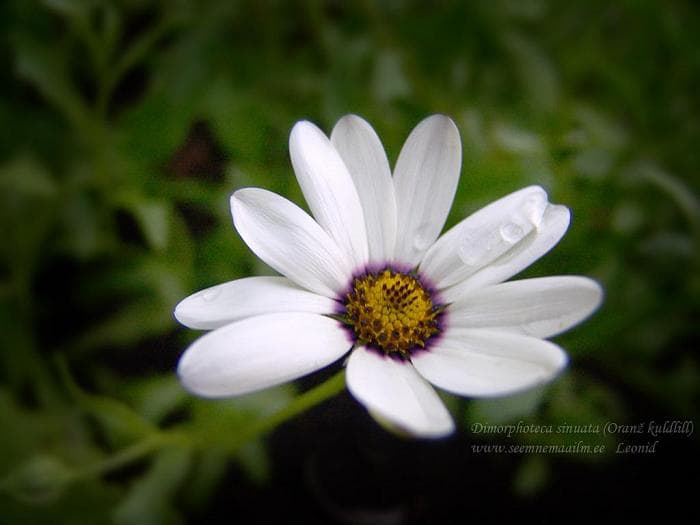Ex Tax: 1.30€
Herbaceous plants with rising stems form a densely leafy, hemispherical bush 30-40 cm tall.
Inflorescences are single apical baskets. Reed flowers are white, yellow or orange above, purple or purple below; tubular - small, dark brown.
The inflorescences are open only during the day and in sunny weather. They prefer loose, sandy loam soils, somewhat fertilized with humus. They do not tolerate excess soil and air moisture.
Used for flower beds, group planting and mixborders. It is better to do without transplanting and sowing seeds in the spring immediately to a permanent place, and then thinning out the seedlings.


Location: Dimorphotheca - light and heat-loving plants. Therefore, a sunny place is chosen for them, the southern slopes are best suited.
Soil: should be very loose, permeable, but not rich in nutrients. In fertilized areas, plants develop powerful bushes but bloom weakly. They do not tolerate excess soil and air moisture!
Care: usual. Wilted inflorescences should be removed in a timely manner, this promotes the formation of new buds and improves the appearance of plants.
Reproduction: seeds, which are sown in early April in greenhouses. The optimum temperature for germination is + 16 ° C, seedlings appear 7-14 days after sowing. Grown plants dive into 9 cm pots of 3 pieces. In May, you can sow outdoors. Bloom 2-3 months after sowing. Seedlings are planted after the end of spring frosts, maintaining a distance between plants of 15-20 cm. However, dimorphotecs are very sensitive to root damage, which subsequently recover extremely slowly. Only seedlings can be dived into pots, and then some of the plants will die anyway. It is better to do without transplanting and sowing seeds in the spring immediately to a permanent place, and then thinning out the seedlings.
In the conditions of Estonia, this african daisies are sown to a permanent place in mid-May, and after the emergence of seedlings, they are thinned out. Flowering begins 6-7 weeks after germination and lasts 35-65 days.
The seeds ripen slowly and easily fall out of the baskets, they must be collected in several stages. Unripe baskets ripen easily at room temperature. So that the variety does not lose its decorative qualities, it is necessary to collect seeds only from early-flowering large-flowered specimens.
Usage: this annual plants with their graceful radiant inflorescences can decorate any flower garden. They are used both in pure plantings and in combination with other crops, for example, arctotis, ursinia, venidium, acroclinium.
In rocky gardens, it is better to plant them next to the same drought-resistant plants, separating them from more moisture-loving ones.
Partners: it is combined with bright annuals, especially with varieties with white flowers (ageratum, heliotrope, petunia and pelargonium).


African Daisy, Cape Marigold. Bot.syn.: Dimorphotheca aurantiaca DC.












